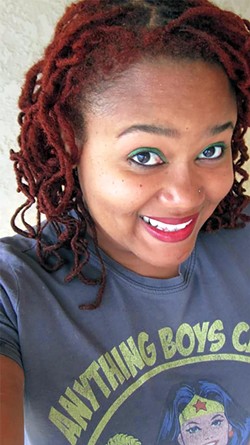
When 33-year-old Monique Martin attends a Pride event, she does so as an out and proud pansexual.
Right on queue, the questions start pouring in the moment she utters the word. Not that she's got a ready-to-go, concise answer.
"It means I fall for all kinds of people and that's a hard concept for people to wrap their head around," she told the San Antonio Current. "It's about being able to love whoever you want without boundaries."
Martin is part of the growing movement in San Antonio that is literally attracted to every adult human under the rainbow. Pansexuality (sometimes also known as omnisexuality) is derived from the Greek prefix pan, which means "all."
Martin feels there are many limitations to "living as straight. I believe in following my heart rather than anything else. My sexual identity just makes sense."
Before she ever makes it down to the Pride funnel cakes, she finds it easier to explain all of the things that pansexuality isn't.
"Being pansexual doesn't mean you want to bang everyone that you see," she clarified. "For me, pansexuality is about acknowledging that sexuality and gender don't fall under a binary scale."
That touches on a common misconception that perhaps should be addressed. Sure, it's about keeping an open mind, but it's not about exploring beyond the human species.
"Some people think pansexuality has something do with goats," she said with a chuckle. "Falling in love with anybody, regardless of identity, has nothing to do with animals."
And there are many who would categorize pansexuality as something that sprang exclusively from kink culture. Back off with the electrical nipple clamps — not quite.
"I don't see it as that," Martin said. "As consenting adults, we can love whoever we want. Kink has nothing do with it. Kink is purely sexual. I don't think pansexuality is purely sexual, just like it's not only a sexual thing in heterosexual relationships."
Like most people, she had to go through certain growing pains before discovering her true identity.
"It wasn't until my late 20s that I identified as [pansexual]," said Martin, a military brat and longtime member of the local comedy troupe Comedia A Go-Go.
"I think people are starting to understand that the [arts and] humanities are complicated things and we should be accepting of everyone and how they choose to identify," she added.
Martin said in SA the LGBT response to her pansexuality has been positive. Perhaps it's due to the mainstream revival and newness of the word in the American vernacular.
Sigmund Freud first coined the term "pansexual" by using it to define sexuality as the basic motive for all human interaction. But the current usage of the word gained popularity in the early 20th century and, according to Google Trends, the word pansexual has been on the steady rise as a search term since 2007.
The really big letters in the queer alphabet soup include heterosexuality, bisexuality and homosexuality. But some, like Martin, fall in between.
"I can only speak for myself," she said. "I can understand how someone would identify as LGBT, but you can be on the cusp."
Pansexual is simply the best way she has found to describe herself. It's also a term that makes sense to Bernard Taylor, though he offered a semantic twist on the designation.
"It should be called pan-romanticism," said Taylor, who's originally from South Africa and lived many years in England before moving to the Alamo City in 2001. "People should feel free to follow their romantic and sexual urges."
Taylor said he feels caught between two worlds. "I've always been pulled in both directions," he told the Current, explaining that calling himself bisexual never felt quite right.
Across the board, pansexuals, like Taylor, have expressed being attracted to someone with their hearts first, rather than physically.
"It depends on the person," he said.
Taylor, who declined to share his age, certainly has experience on the relationship front.
He's had four wives. However, his current relationship, with a man named Jerry, is the first to ever make him feel emotionally settled.
"I haven't looked outside the relationship," said Taylor, adding that he likes guys slightly on the gentle side but not effeminate. "I've always been honest. My last wife knew from the beginning that my first romance was with a man."
Lesbians and gay men, too, may feel uncomfortable dating pansexuals because they often feel they cannot compete with the competition.
So even to this day, Taylor cannot find a neat little box to check for his sexual identity. But that isn't an issue for him. "I don't like labels of any kind," he said.
His long journey to try to understand where he falls within the LGBT umbrella led him to write a self-published book entitled Beyond Gay Stereotypes in 2011.
"There are screaming queens on one side and bears on the other," he said. "I felt like gay people defined themselves by these stereotypes."
At least in the land of the free, some see a beauty in the spinning diversity of glittering queens, endearing bears and those in between.
But today's use of the word diversity may seem pretty square in the decades to come. It could be that the rise of pansexuality will one day be viewed as a bridge between the dominant heterosexual world and everyone else under Gilbert Baker's (benevolent) rainbow flag.

